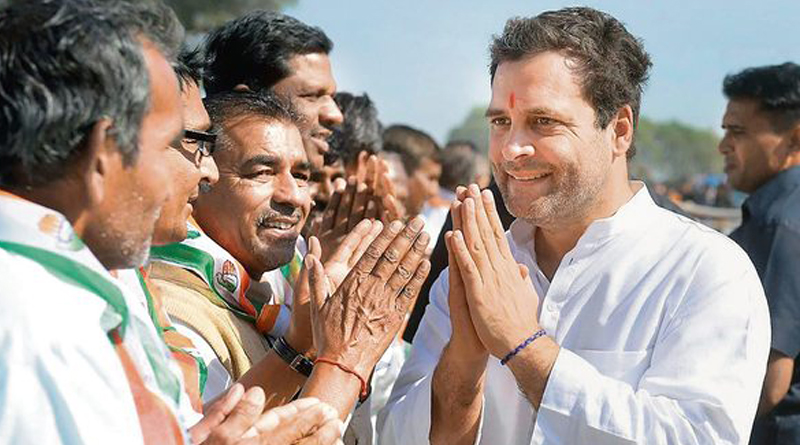Indira Gandhi’s ‘Garibi Hatao’ swept the polls in 1971. Rahul Gandhi hopes to follow suit with NYAY (Nyuntam Aay Yojana), promising a minimum income of Rs 72,000 per year to the 50 million poorest families. Garibi Hatao flopped badly. So will NYAY unless totally rethought.
Indian parties have a consensus on cash grants to the needy. Schemes in Telangana, Odisha and Jharkhand have been followed by Modi’s PM-Kisan, costing Rs 75,000 crore per year. Achieving that without fiscal profligacy is difficult. Rahul’s NYAY will cost almost five times more, Rs 360,000 crore, or 1.8% of GDP.
Horrendous problems and leakages will arise in identifying the poorest 20%. India has no income surveys. People will hide their true income to qualify, so the biggest liars will be the biggest gainers. Income certificates from sarpanches or officials will breed huge corruption. Many poor people live in remote non-electric unbanked areas, almost unreachable by cash transfers. NYAY will make the bottom 20% richer than the lower middle 20-40%, who will, rightly, howl that this is arbitrary and unfair.
How will Rahul finance NYAY? Not by a big GST hike: that could be almost as inflationary as printing notes. Besides, he has long said indirect taxes (especially on auto fuels) are too high. He could raise corporate tax rates. But that will ruin the existing policy of lowering the tax rate plus cess/surcharge (34.5% for large companies today) to 25% to compete with other Asian nations. India must be tax competitive to take on China (15-25% corporate tax) in the RCEP (Regional Comprehensive Economic Partnership) free trade area.
Today’s entire income tax collection is barely 2% of GDP. Doubling this is impossible quickly. History shows that, beyond a point, high tax rates produce a black economy, not revenue. Indira Gandhi raised income tax to 97.75% but got no tax bonanza. By contrast Manmohan Singh and Chidambaram slashed it in the 1990s from 50% to 30%, yet improved the income tax/GDP ratio, by inducing more tax honesty.
Many tax exemptions and exceptions are unwarranted and should be scrapped. They are already being phased out. Hence the effective tax rate has gone up from 19% to almost 28% for large corporations. Yet this reduction of tax breaks has produced only modest revenue.
Rahul could slash spending. Doing so on health, education and infrastructure would be disastrous: such spending needs to rise, not fall. Existing subsidies on food, fertiliser and fuel could be abolished to fund NYAY. But political competition make it impossible to end existing subsidies. Rahul has always favoured additional subsidies, not less.
He could borrow more (increase the fiscal deficit). But interest rates will rise, hitting not just businesses but household borrowers. Higher interest payments will squeeze essential government spending. The trade deficit will widen. The rupee will depreciate, raising prices and hitting dollar inflows. The new target under the Fiscal Responsibility and Budget Management law of reducing the public debt from 70% of GDP to 60% will become impossible.
Lest this be labelled a right-wing attack on NYAY, let me cite some top leftist economists.
Pranab Bardhan: “India does not officially collect income data, so identifying the poorest 20% is difficult… Getting income certificates from some officials can be a highly corrupt process.”
Amiya Kumar Bagchi: “There will be information problems for migrant contract labourers working in brick kilns and sugar plantations… For the poorest living in pipes, underneath bridges and very temporary squatments, there will be a problem of identity. Most of them will not have ration cards and Aadhaar cards.”
Jayati Ghosh: “We simply don’t have income data… last SECC survey is from 2011 is also a concern since the data is now outdated. You would need a fresh survey.”
R Ramkumar: “These minimum income schemes would mean a lot for someone living in Jharkhand but will not have the same effect for someone in Kerala (where the daily wage itself is around Rs 1000). There must be an extensive and detailed survey to understand the household and income characteristics across districts and states before a scheme like this can be launched. It will take at least three to four years to conduct such a survey.”
Odisha’s Kalia (Krushak Assistance for Livelihood and Income Augmentation) is the best cash transfer scheme. It benefits all rural households — farm owners, tenants, landless labourers. Equitably, it excludes big farmers. Odisha’s land records have been updated, so identification errors should be low. Kalia is fiscally prudent.
A Central Kalia will have identification problems but will be better than Modi’s scheme, which benefits only farmowners, not tenants or the landless. Telangana’s Rythu Bandhu benefits large farmers the most, with nothing for tenants or labourers. NYAY is easily the biggest, but has fatal conceptual and practical flaws.


